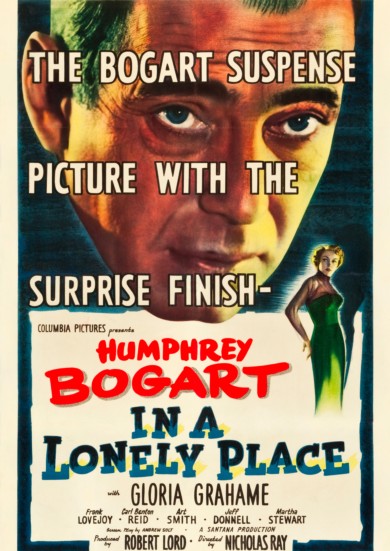In a Lonely Place
Humphrey Bogart plays an angry alcoholic screenwriter who is the prime suspect in a brutal murder. Gloria Grahame plays his neighbour, a would-be actress who gives him an alibi but starts to have doubts. A superior film noir from Nicholas Ray.
Film Notes
In a Lonely Place: An Epitaph for Love.
"It was his story against mine, but of course I told my story better.” There is a glint of real pride in screenwriter Dixon Steele’s wry boast to his agent about matching wits with a police detective. Dix (Humphrey Bogart) may despise Hollywood’s philistine “popcorn salesmen,” but he is dedicated to the art of storytelling, which is the true heart of Hollywood cinema. In a Lonely Place (1950) savagely sketches the vulgarity and shallowness of Tinseltown—the autograph hunters, the crassly arrogant stars, the vacuous audience and the moneymen eager to feed its appetite. But what makes this a heartbreaking tragedy instead of a jaded satire is that, beneath its bruised pessimism, the film still clings to the hope that art and integrity and love can survive in the wasteland—a hope that dies slowly, agonizingly before our eyes.
Very loosely based on Dorothy B. Hughes’s excellent 1947 novel, with which it shares little aside from some superficial elements and that peerless title, Nicholas Ray’s film was deeply personal for the director and the star. Both men could relate to Dix’s bitterly conflicted feelings about serving a meretricious industry. Ray, who defined himself as an outsider and frequently clashed with producers over his habit of rewriting scripts and improvising on set, clearly identified with Dix Steele; he even modeled the character’s home on Villa Primavera, the West Hollywood apartment house he had first lived in after he arrived in Los Angeles. Ray wound up sleeping on that set rather than going home, as his short marriage to Bogart’s costar, Gloria Grahame, was disintegrating—another factor in the blurring of art and life that surrounded the film’s making and shapes its story.
Bogart produced the film through his independent Santana Productions, founded in a bid for greater artistic autonomy, and gave his greatest performance in a role that Louise Brooks, among others, thought came closest to his real character. From the opening shot of his eyes reflected in a rearview mirror as he drives the dark streets of L.A., he reveals a bleak and toxic inner life. The eyes in the mirror dart like those of a wounded and cornered animal. Insolence and the flicker of banked-down anger were always Bogart’s trademarks, but here his temper becomes nasty, needling and bullying yet somehow coexisting with a refined and generous intellect. His sudden mutations from civilized charm to grotesque fury are terrifying: his body stiffens, his mouth contorts, and a clotted, mean-drunk glitter comes into his eyes. Bogart’s performance is both a rebuke to the myth of the cool, unflappable hero—a myth that he, more than anyone else, still embodies—and a riskily honest commentary on his real-life penchant for booze-fueled brawls.
As an actor, Bogart was always principally an observer, and he milks a lot of humor from Dix’s pained reactions to Mildred Atkinson (Martha Stewart, in a brilliant, brazenly comic performance). He brings this ditsy hatcheck girl home to tell him the story of Althea Bruce, a schmaltzy best seller he is supposed to adapt for the screen. Mildred’s murder, after she leaves his apartment, brings Dix together with his neighbor Laurel Gray (Grahame), who comes to the police station to give him an alibi. It looks like the story will turn into a whodunit, but the film is as uninterested as Dix in who killed Mildred. He even seems ready, with a writer’s detachment, to accept her death as the plot device that helps him find the woman he was seeking.
In a Lonely Place is both a meditation on screenwriting and an example of the craft at its finest. (As was often the case with Hollywood films of this era, the writing credits are somewhat misleading: Edmund H. North receives one for his adaptation of the Hughes novel, but that was almost entirely abandoned by Andrew Solt in his original script, which in turn was heavily revised during shooting by an uncredited Ray—a history that forms an intriguing parallel with Dix’s own refusal to follow the book in his screenplay for Althea Bruce.) Dix constantly views life as though it were a script he was writing—one wonders if he notices the echoes of Althea Bruce’s silly plot in his own relationship with Laurel—and Ray uses the character’s shoptalk as a scalpel with which to probe the gap between movies and reality. Fixing breakfast for Laurel after they have become lovers, Dix explains that “a good love scene should be about something else besides love.” To illustrate this, he uses the scene at hand: he clumsily hacking away at a grapefruit, she half-asleep in her negligee: “Anyone looking at us could tell we were in love,” he says, but doubt edges into his voice. Laurel is not dopey with sleep, she’s paralyzed by fear of this unpredictably violent man. The scene is indeed about something besides love: it’s about love strained to the breaking point by lack of trust.
When he proposes to her, in the same scene, the exchange might belong to a deft romantic comedy. Dix says offhandedly that the housekeeper thinks they should get married so she has a chance to vacuum the apartment, and Laurel quips, “Isn’t there a simpler way?” But her expression, under the sly eyebrow and the dry twinkle of a smile, is stricken. He is nervous, clenching and unclenching his hands, awkwardly pressing her for an answer. She says yes but means no, and as they kiss her eyes stay open, planning her escape. Dix is right that the scene, sad and funny and unsettling all at once, is a lesson in good screenwriting.
Dix knows how to craft scenes on paper, but he can’t control the ones in his life, which keep devolving into pointless mayhem. Like the characters played by Robert Ryan in Ray’s On Dangerous Ground (1951) and Dana Andrews in Otto Preminger’s Where the Sidewalk Ends (1950), Dix is a tightly wound man who finds release in violence but is isolated by his brutality. Unlike them, he is not sick with self-loathing or guilt; he justifies or tries to make easy amends for his behavior, and a few loyal friends even back him up. He’s a genius, and after all, the world is full of phonies and jerks. But any romantic aura around Dix is shattered by the horrible moment when he slaps his meek, long-suffering agent, Mel (Art Smith), breaking his glasses.
This small, pathetic moment is even more disturbing than when Dix slugs a stranger in a traffic altercation, or when he shows how easily he can identify with Mildred’s unknown killer. Like a director talking actors through a scene, he talks his police detective friend Brub (Frank Lovejoy) and his wife through his imagined version of the murder, describing how the man crushed the girl’s throat in the crook of his arm as he drove. Dix’s face lights up with sinister excitement as he inhabits the killer’s ecstatic vengeance, though he insists his “artistic temperament” would never allow him to dump Mildred’s body from a moving car. Later, sitting in a car with Laurel after another ugly brawl, Dix puts his arm around her neck in exactly the same gesture he imagined the killer using. In this disquieting moment, he suddenly recites some lines he has written for his screenplay, trying them out: “I was born when she kissed me. I died when she left me. I lived a few weeks while she loved me.” Laurel suggests the lines might go in “the farewell note.” They seem to be rehearsing for their own separation as they parse this epitaph for love.
Dix and Laurel, an unsuccessful starlet, both know by heart the conventions of Hollywood romance. That ideal of simmering rapport underlies their first exchanges of glance and gaze and repartee, cinematically framed by the courtyard of their Spanish-style apartment complex. They are as attractive as any movie couple in the blissful first weeks of their affair, with their mixture of easy, playful intimacy and constant appreciative surprise. They picnic on the beach; they sip drinks in a piano bar, whispering in each other’s ears, sharing jokes and cigarettes. (Hadda Brooks’s performance of “I Hadn’t Anyone Till You” is a perfect accompaniment to this vision of sophisticated, grown-up romance, and blends well with George Antheil’s somber, brooding score.) He makes breakfast for her, and she puts him to bed after a hard night’s work; they play house as Ray’s characters often do, finding a haven all the more precious for being impermanent—like the three teenagers in an abandoned mansion in Rebel Without a Cause, or the fugitives Bowie and Keechie in a series of motels in They Live by Night.
Just as Bogart peels off the mask of the hard-boiled hero to reveal insecurity and self-destructiveness, Gloria Grahame finds shades and angles in the stock roles of woman as redeemer or victim. With her lisp and dimpled pout, Grahame was best known for playing provocatively masochistic, damaged sexpots, but here her sidelong wit and irrepressible left eyebrow bring out a much subtler allure. At first glance, she’s a dream girl—or rather a mature and quietly stunning woman, “not coy or cute or corny,” as Dix remarks, captivated by Laurel’s elusive reserve and “good guy” frankness when she comes to the police station. But her elegant poise conceals a fatal weakness: if his default reaction to trouble is to lash out, hers is to run away. A “get-out-before-you-get-hurt type” who is nonetheless drawn to a dangerous and erratic man, Laurel is one of the most psychologically complex women in film noir. Bogart, not surprisingly, wanted Lauren Bacall for the part (Warner Bros. refused to loan her, and Ray ultimately insisted on his wife over Harry Cohn’s preference, Ginger Rogers), but Grahame’s troubled intelligence and sensual vulnerability make her more moving than any other actress would have been.
As the film progresses, its center of gravity shifts from Dix to Laurel, and as they are pulled apart, you are torn by an anguished ability to see both sides—what is irresistible and what is unforgivable in this man and in this woman. The love that at first brings out the best in each ends up bringing out the worst: Dix’s violent jealousy, Laurel’s fear and panicked lies. It is clear that this love is the last chance for both of them, the failure from which they won’t recover. Hollywood’s dread of failure hangs over all the characters. Dix, who hasn’t written a hit since before the war, may defy the culture of success worship, befriending a drunken, washed-up Shakespearean actor (an obvious John Barrymore stand-in played by Robert Warwick), but he hungers for recognition too, even from a world he despises. One of the film’s saddest lines is spoken by Mel, hoping that the sale of the screenplay will make up for Laurel’s abandonment: “If Dix has success, he doesn’t need anything else.”
In a Lonely Place is often grouped with Billy Wilder’s Sunset Boulevard and Joseph Mankiewicz’s All About Eve, all released the same year and all laying bare the cruelty and delusions embedded in show business. But those other films are far more satirical and cold-eyed than In a Lonely Place, which draws the audience into such vulnerable intimacy with its characters. The cleverly detailed interiors, Jean Louis’s elegant costumes, the sharpness of minor characters like Laurel’s creepy masseuse and Dix’s acerbic ex-girlfriend, all create a fully lived-in world. But the film’s reputation, which has grown over the years since its release to mostly good reviews but poor box office, does not rest on admiration for its craft. There is something intensely personal in people’s love for this movie, which fits neatly in no category.
It is a film noir, one of the greatest, but also one of the freest from the usual genre trappings. This is not a world of guns and blind alleys, neon-lit hotel rooms and suitcases of cash, or a darkly gleaming world of the corrupt rich sweeping up and down curved staircases. Burnett Guffey’s cinematography uses a subtle palette of grays, eschewing strong contrasts, extreme angles, and expressionistic close-ups. More essential to the film’s look are shots in which two people are framed in a tense balance of attraction and distrust that gives the compositions sculptural weight.
The film’s ending—devastatingly perfect, perfectly devastating—seals its rejection of the commonplaces of Hollywood melodrama. Ray claimed that he improvised the final scene on the set with Bogart and Grahame, after shooting the more heavy-handedly ironic ending in the original screenplay. He crafted instead an anticlimax, with a drained and burned-out flavor, that is one of the few genuinely tragic endings in noir. With all its deaths and defeats, noir rarely breaks your heart: fatalism and cynicism are defenses against heartbreak. But Ray’s romantic temperament was never hardened against disappointment. For a fleeting spell, we can believe that love will transform Dix and Laurel, and so it is crushing, if inevitable, when they return to the fixed orbits of their barren lives. When she recites his words (with one crucial change: “I lived a few weeks while you loved me”), Laurel translates them from movie poetry into what feels almost unbearably like real life.
Imogen Sara Smith, https://www.criterion.com/ May 10th 2016.
Nicholas Ray’s melodrama, from 1950, is one of the darkest, harshest, and most devastating love stories ever made. It’s an inside-Hollywood story, starring Humphrey Bogart as Dixon Steele, a gifted screenwriter with a mean streak. Dixon meets his dream woman, Laurel Gray (Gloria Grahame), a fledgling actress, the very night that another woman he was with is found murdered, and he comes under suspicion. The clash of movie-world scandal with local politics gives the passionate affair a broad backdrop, as does Ray’s fervent depiction of fragile, high-strung artists caught between love and work. Ray—who was married to Grahame at the time—endows the couple’s intimate moments with a bittersweet ardor (which gives rise to a love scene in which Dixon describes how he writes love scenes). The stars are joined by a superb batch of character actors, in such roles as a sentimental agent and a Falstaffian thespian, in sequences that play like bruising chamber music, with two-person face-offs, triangular confrontations, and jousting quartets. Few movies suggest such a forthright flaying of the director’s soul.
Richard Brody, The New Yorker,
Humphrey Bogart is in top form in his latest independently made production, "In a Lonely Place," and the picture itself is a superior cut of melodrama. Playing a violent, quick-tempered Hollywood movie writer suspected of murder, Mr. Bogart looms large on the screen of the Paramount Theatre and he moves flawlessly through a script which is almost as flinty as the actor himself. Andrew Solt, who fashioned the screen play from a story by Dorothy B. Hughes and an adaptation by Edmund H. North, has had the good sense to resolve the story logically.
Thus Dixon Steele remains as much of an enigma, an explosive, contradictory force at loose ends when the film ends as when it starts. Because Mr. Solt did not compromise to fabricate a happy ending the climax packs both surprise and a punch. Although Steele is callous, insulting and vicious in his dark, ugly moods, he can be tender and considerate under the influence of love and has a deep, spontaneous affection for a broken-down old star who is aglow with brandy and Shakespeare.
Mr. Bogart plays the role for all its worth, giving a maniacal fury to his rages and a hard edge to his expressions of sympathym. Mr. Solt lets go with a few sharp barbs at the dynasty system in movieland in the course of involving Dixon Steele in the murder of a hatcheck girl and a torrid romance with a satiny blonde neighbor whom he meets formally in the Beverly Hills police station. Steele is suspected because he was the last one to see the victim alive and the police just won't accept his story that he dated the girl and took her to his house simply because she had read a book he had been asked to write into a screen play. His reasoning was simple; why waste time reading a book he might not like if somebody could give him the plot in half the time? The police won't buy that one, but Laurel Gray "buys" the scenarist.
Theirs is a hectic romance under constant police surveillance with the high-strung Steele flying into rages which gradually frighten Laurel and lead her to believe that the police may not be so far wrong after all. We won't, of course, go any deeper into the story, but through it all Steele has the arrogance of a brilliant creator of fiction murder who sneers at the bafflement of the police. Mr. Solt in shaping the character of Steele makes no attempt to psychoanalyze him and neither does Mr. Bogart in his performance, but the actor plays with such terrific drive that one is content not to pick the characterization apart.
Gloria Grahame gives a smoldering portrayal of Laurel; Robert Warwick is expansive in a wonderfully Smithfieldian way as the fallen star, and several lesser roles are well played by Frank Lovejoy, Carl Benton Reid, Art Smith, Jeff Donnell, Martha Stewart and Hadda Brooks, as a torch singer. Mr. Bogart had a good team, marshalled by Director Nicholas Ray, and the result is that "In a Lonely Place" comes off a dandy film.
Bosley Crowther, The New York Times, May 18th 1950.
What you thought about In a Lonely Place
Film Responses
| Excellent | Good | Average | Poor | Very Poor |
|---|---|---|---|---|
| 5 (71%) | 2 (29%) | 0 (0%) | 0 (0%) | 0 (0%) |
|
Total Number of Responses: 7 Film Score (0-5): 4.71 |
||||
Collated Response Comments
"Bogart was Raymond Chandler's favourite screen tough guy (damningly declaring Alan Ladd to be 'A small boy's idea of a hard man') and for good reason. Not so much the trench coated knight errant of his roles as Chandler's Marlowe here though, more the hair trigger, borderline psychotic of 'Treasure of the Sierra Madre' and 'The Caine Mutiny'. He convinces as a self driven alpha male whose patience and temper has been worn perilously thin by the grinding gears of the dream machine. With Grahame, Hollywood's most mercurial femme fatale, helping drive the febrile atmosphere and inevitable headlong gallop towards disaster this is classic noir. It oozes class all the way. Excellent."
"Phew - at times an elusive film noir, moody and turbulent in its emotions. A very personal film for Nicholas Ray, I guess, with Ray's wife (Grahame) playing a tired actor (Laurel) initially at a distance then more centre stage with Dix Steele (Bogart) a deeply flawed screen writer with no work. The connection between them gives a depiction of love so tangled and complex, from Grahame typing the script from a limited book, to giving Steele the love he craves, apparently tenderly, eagerly reciprocated but tragically in the end as with good melodrama. Neil Young sang 'Only love can break your heart'; thought the characters reflected that well., with 'Hollywood' getting a veiled bashing with some caricatures – the washed-up screen writer, the alcohol soaked actor, a whizzkid director, a long-suffering agent – all add much to this melodrama. I liked the hints of what was to come from the soon to be murdered hat-check girl saying "I already know the end. I always read that first." Bogart's violence threads its way through, him accused of murder, gaining some redemption but in the end the man faces the perpetual return of former mistakes, and we don't know if he can rewrite himself as a new character. Again, a striking film – thanks"
"Great to see a Bogart film on the big screen. I hadn't seen this one before and thought it was very good. I've always found Bogart more convincing as a bad guy rather than the good guy and he was suitably menacing in this. Even more so Gloria Grahame was a revelation, I thought she was excellent, and I will search out more films with her".
"Great film, tense and intense. The subject matter seemed bang up to date but the advice Mel gives Laurel to 'take the rough with the smooth' for the sake of Dixon's creativity sounds shocking today".
"Had not seen this before and given how good it was found that surprising. Bogart excellent in an almost schizophrenic role, one minute loyal and charming another psychotically attacking people for very little reason. Well paced and kept you engaged throughout, although some really awful acting - did Junior's father own the studio?! Another great choice. Thanks".
"I enjoyed this Bogey Film Noir, as a good part of the GFS mix this season. I wouldn't want loads of noirs, but I wouldn't want to be without them, and I think this was an excellent choice; many strands of story and comment on the industry at the time. But I wasn't the only person last night to be puzzled by the comments of the "doctor" who appeared in one of the last scenes at the police station, saying that he'd extracted a bullet from Kelsey's lung, and that he was lucky to be alive. No further reference was made to this, and it didn't seem to fit in with the plot; who would have shot him? Mildred? Dix? a policeman? I've looked at the script online - no clues there. Can anyone enlighten me? "



